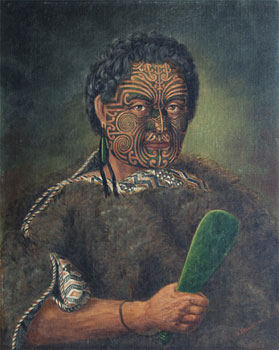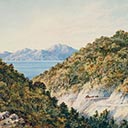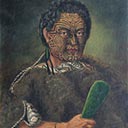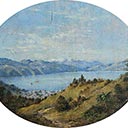Te Pehi Kupe, Warrior of the Ngati Toa Tribe
37 x 29 cm
est. $20,000 - 30,000
Provenance: Private Collection, Victoria, Australia
Te Pehi Kupe (b.? - 1828) is remembered as a warrior leader of the Ngati Toa tribe, whose territories extended from Porirua to Wairau and Nelson. Te Pehi Kupe is one of the most colourful characters in the early history of the young colony. Following in the footsteps of Hone Heke, Pehi Kupe decided to visit England in a bid to acquire arms and ammunition. In 1825 Captain Reynolds of the ship Uranea writes the following account to the Earl of Bathurst:
As I was passing through Cook's Straits on the 26th February, 1824, I was becalmed about five or six miles from the land when I perceived three canoes full of savages coming towards the ship. I then prepared the ship ready for action. The grand war-canoe then came within hail, and by motions I made them understand to keep off. The chief Tippahe Cupa (Te Pehi-kupe) showed every sign of peace, and I perceived shortly after they were all peaceably inclined. The chief, in his great war-canoe, came alongside, which I could not prevent unless I had fired into them; and if I had, a good deal of mischief might have been done. The man jumped on board naked (except a mat over his body, leaving the remainder of his dress in the canoe) and made signs for arms, and I gave him to understand I had none to give him, and then he led me to understand that he would stay on board and go to Europe and see King George, which words he pronounced plain enough to be understood. I then ordered him to go into his canoe again, but he had ordered her off and would not allow her to come near the ship. I attempted to heave him overboard so as the canoes might pick him up. But he, perceiving my design, put it out of my power.
A breeze at that time springing up he ordered all the canoes to leave for the shore, and told them he was going to Europe and that he would soon return again (as he has told me since). The next day I attempted to put him ashore near the eastern mouth of Cook's Straits, and in doing so I only just escaped losing the ship, therefore I was obliged, much against my inclination, but to his satisfaction, to make sail and leave the island for my port of destination-Lima…. This man, when he came on board, was a complete savage, but I have taken a great deal of pains with him to civilize him, for when I was in Lima he lived ashore with me; wherever I went he went with me. He lived on shore with me at Montevideo and at Buenos Ayres, and all the time he was on board he lived at my table, and I clothed him and kept him clothed in European fashion ever since he came under my care. He has been a heavy expense to me these thirteen months."…
On arrival in England Te Pehi was nursed through a bout of measles by Captain Reynolds. Once recovered, he was presented to King George IV, taught to ride a horse and given gifts of clothing and agricultural tools. On 6 October 1825 Te Pehi left England on board the Thames. When the ship landed in Sydney the enterprising Te Pehi sold his gifts and bought the sought after arms and ammunition. On his return to New Zealand these weapons were of use in Ngati Toa's invasion of the South Island lead by Te Rauparaha. It is recorded that Te Pehi and his warrior companions proceeded south to the Ngai Tahu Pa at Kaiapoi. Here a dispute developed over a block of greenstone and Te Pehi was killed whilst sleeping. In a fittingly dramatic end to an extraordinary life, Te Pehi's body was cooked and eaten and his bones made into fish hooks.
In this work, and a similar one hung in the collection of the Auckland Art Gallery, Samuel Stuart portrays Te Pehi with full face moko. Stuart also painted distinctive scenes of early Auckland. He exhibited with the Auckland Society of Artists in 1877. His work is rarely seen at auction.





